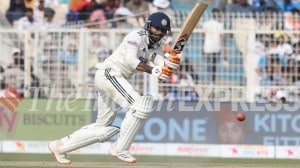In first meet for FY25 in April, why MPC will likely keep repo rate unchanged
According to Deutsche Bank’s Das, the RBI is expected to keep its FY25 CPI inflation forecast unchanged at 4.5%, while the next fiscal year's growth forecast could be raised to 7.4% from the current 7%.
 RBI Governor Shaktikanta Das (File Photo)
RBI Governor Shaktikanta Das (File Photo)The Monetary Policy Committee (MPC) of the Reserve Bank of India (RBI) will hold its first meeting for the financial year (FY) 2024-25 between April 3 and 5. The panel is widely expected to keep the repo rate, the key policy rate, unchanged and maintain the ‘withdrawal of accommodation’ policy stance. Analysts said the central bank will be cautious as continuing risks to food inflation could affect consumer price index (CPI) or retail inflation.
What is expected from RBI’s forthcoming monetary policy meeting?
 The MPC will likely keep the repo rate — the rate at which the RBI lends money to banks to meet their short-term funding needs — unchanged at 6.5%. After a 25-basis point (bp) hike in February 2023, the rate has remained unchanged at this level over seven straight MPC meetings. One basis point is one-hundredth of a percentage point.
The MPC will likely keep the repo rate — the rate at which the RBI lends money to banks to meet their short-term funding needs — unchanged at 6.5%. After a 25-basis point (bp) hike in February 2023, the rate has remained unchanged at this level over seven straight MPC meetings. One basis point is one-hundredth of a percentage point.
The MPC meeting comes after the US Federal Reserve decided to hold its interest rate steady at a range between 5.25% and 5.2% and the Bank of Japan (BoJ) raised its rate for the first time since 2007 — and ended an eight-year negative interest rate regime. The BoJ hiked the interest rate to a range of zero to 0.1% from (–) 0.1%.
Why is the RBI expected to remain cautious?
The government has mandated the RBI to keep inflation at 4% with a comfort band of 2% in both directions. In February, retail inflation stayed largely flat at 5.09% against 5.1% in January.
Analysts said unless the 4% target for inflation is achieved on a durable basis, RBI is unlikely to cut the repo rate.
“We expect the RBI to take comfort from declining core inflation, slightly soften its hawkish forward guidance, but remain cautious given upside risks to food inflation from weather shocks, and repricing of the Fed funds rate easing path,” said a Goldman Sachs report.
“We expect the RBI MPC to keep the policy repo rate unchanged at the April 5 meeting at 6.5%, retain the monetary policy stance of ‘withdrawal of accommodation’, sound optimistic on growth, and continue to reiterate the commitment to the 4% headline inflation target,” the report said.
Strong growth in fiscal year 2024 and higher growth projections for FY25 give leeway to the RBI to wait for actual monetary easing in advanced economies, said Deepak Agarwal, Chief Investment Officer, Debt, Kotak Mahindra AMC.
Finance Minister Nirmala Sitharaman Saturday said she expects growth in the fourth quarter (January-March 2024) to be 8% or above 8%, which will push FY24 GDP growth to an average of 8% or more. The economy expanded by 8.2%in Q1, 8.1% in Q2, and 8.4% in Q3. For FY25, the RBI’s real GDP growth projection is 7%.
What about the monetary policy stance?
While it is widely expected that the MPC will continue with the ‘withdrawal of accommodation’ stance, some analysts see a chance that the panel will change it to ‘neutral’.
“Both repo rate and stance (are) likely to remain unchanged under base case scenario; but can’t rule out the possibility of a change of stance to neutral, given past evidence of the central bank surprising with its decision, particularly in April,” said Kaushik Das, Chief Economist, India & South Asia, Deutsche Bank.
If RBI indeed changes its stance to neutral, the accompanying statements and comments are expected to be hawkish. On the other hand, if the central bank maintains the ‘withdrawal of accommodation’ stance — as a majority of the market participants expect — the commentary may be less hawkish, Das said.
Will RBI change inflation and growth projections?
According to Deutsche Bank’s Das, the RBI is expected to keep its FY25 CPI inflation forecast unchanged at 4.5%, while the next fiscal year’s growth forecast could be raised to 7.4% from the current 7%. “Our own CPI forecast for FY25 is 4.6%, similar to RBI’s, but our real GDP growth forecast for next fiscal year is 6.5%, lower than the central bank’s estimate,” he said.
What happens to lending rates if the repo rate is unchanged?
With the RBI expected to leave the repo rate steady, all external benchmark lending rates (EBLR) that are linked to the repo rate will not increase. This will come as relief to borrowers as their equated monthly instalments (EMIs) will not increase.
Lenders, however, may raise interest rates on loans that are linked to the marginal cost of fund-based lending rate (MCLR), where the full transmission of the 250-bp hike in the repo rate between May 2022 and February 2023 has not happened.
When is RBI expected to cut the repo rate?
The Goldman Sachs report forecasts a 25-bp cut each in the third and fourth quarter for the 2024 calendar year.





- 01
- 02


























